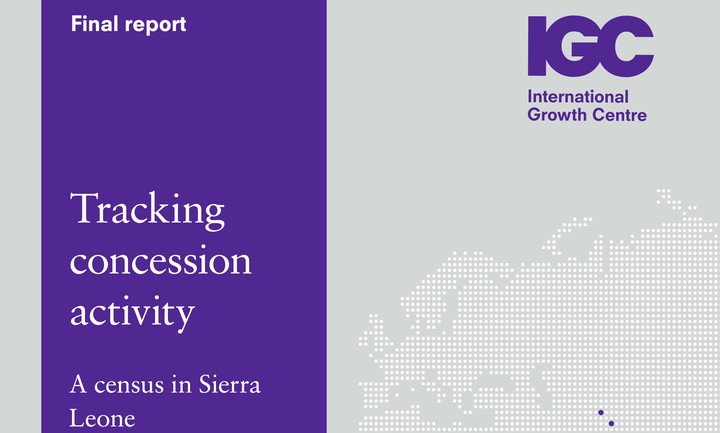Tracking Concessions in Sierra Leone

Full Report: Tracking Concessions: A Census in Sierra Leone
Funding for this research provided by the International Growth Centre (IGC).
Executive Summary
Data Collection
This report summarizes findings from a nation-wide census to catalog mining and agricultural investment activity across Sierra Leone. Fieldwork was conducted over the course of 2017 and involved four sequential activities:^[Innovations for Poverty Action (IPA) Sierra Leone implemented these research activities.]
- Compilation of Data from Central Government (GoSL)
- Cross-Validation with Local Governments
- Field Verification and Surveys
- Phone Survey
We use this data to provide an overview of commercial mining and agriculture in Sierra Leone and highlight the need for better monitoring of these sectors.
Concession Activity
Official government concessions records are not current. Of 462 projects,^[387 came from GoSL records and an additional 75 were discovered by further contacts with local government sources. We use the terms project, site, and concession interchangeably. The same firms can own multiple projects.] enumerators could not locate almost half (218 sites) when they attempted site visits. Where sites could be located, 129 were active projects operated by 106 unique firms over 67 Chiefdoms.
For the 129 active projects/sites:
- 93 were agricultural businesses commonly growing crops such as rice, cassava, palm oil, and eggs;
- 36 were mining projects; 16.7% are considered large-scale and most began after 2010;
- 58% of agricultural businesses were owned by Sierra Leoneans compared to 16.7% in mining operations; and
- Roughly 33% of employees were drawn from nearby communities, with an even smaller proportion being employed in skilled positions.
Other projects were either closed (113 sites) or had been relocated (2 sites).
Lease Terms
Most lease agreements are between the project and a single community. Lease agreements averaged of 18–20 years for agriculture and 6–8 years for mining concessions. Firm representatives claim to have more formal leases (firms report 59 leases; community members, only 50) covering more land (firms report 126 acres on average; communities, 109 acres).
Disagreements between firms and communities involve claims of inadequate local employment and development expenditure and delayed surface rent payments. These disagreements are reported by both firms and communities, though communities report more such conflicts. Disagreements do not tend to end in violence, though it is not uncommon for road blocks or mass agitation to occur.
Recommendations
There are three main recommendations provided in this report:
-
Better, More Regular Monitoring of Commercial Investment: Official records should be regularly updated to avoid over-reporting commercial activity. GoSL needs to implement a more robust monitoring strategy to locate investments, track their production, and identify what areas are available for concessions.
-
Improved Data Systems and Data Collection: Future attempts at tracking concession activity should include: (i) cross-checking GoSL’s records with information held by Chiefdom and District officials; (ii) storing information for concession sites in a cadaster; (iii) visiting each concession site to directly observe its status and activities; and (iv) creating a survey instrument that enables both the verification of existing data and the entry of new sites.
-
Stronger Local Accountability and Dispute Resolution Systems: Compared to claims by communities, firms claim to have signed more leases, granting them control over more land for longer times; hired more people and provided more skills; promised less and delivered more. The only thing firms and communities seem to agree on is that they disagree on these issues — particularly on employment, surface rent payments, and local development projects. There is clearly need for more local accountability for firms and communities to ensure that promises are clearly communicated, mutually agreed upon, and fulfilled. This will enable both both firms and communities to benefit from commercial investments.
Research & Policy Relevance
Over the past decade, foreign investments in developing countries’ agriculture and mining sectors have increased dramatically. A recent report suggests that investors seek out relatively weak states which lack the capacity to regulate and monitor new agricultural and mining projects (Deininger and Byerlee, 2011).
Before we can assess the impacts of these investments on local welfare or government revenues, we first need a detailed record of where, when, and at what scale these investments have been made. In this report, we conduct a census of all agricultural and mining concessions in Sierra Leone and, in so doing, hope to enable a broader research agenda tracking the social and economic consequences of these commercial investments in natural resources.
The outcomes of the current study can also inform ongoing policy debates. Sierra Leone relies heavily on resource endowments: in 2012, the mineral sector accounted for 71% of total export revenues, while agriculture accounted for 70% of employment (Bermudez-Lugo, 2012). The Government of Sierra Leone’s “ Agenda for Prosperity” (2013) and 2015 Land Policy both promote large-scale investments in natural resources. Accurately tracking concession activity enables GoSL and third-parties to evaluate whether the government is attracting new investments and whether those projects are delivering the intended fiscal benefits.